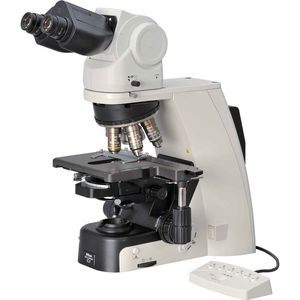
- Laboratory
- Laboratory medicine
- Infrared microscope
- Nikon Instruments

- Products
- Catalogs
- News & Trends
- Exhibitions
Infrared microscope Eclipse FN1for researchbiologicalupright
Add to favorites
Compare this product
Characteristics
- Type
- infrared
- Applications
- for research, biological
- Ergonomics
- upright
- Microscope head
- trinocular
- Observation technique
- multiphoton, confocal, DIC
- Configuration
- benchtop
- Other characteristics
- high-resolution
- Weight
12 kg
(26.5 lb)- Length
655.2 mm
(25.8 in)- Width
633.5 mm
(24.9 in)
Description
Visualizes minute details within thick specimens with perfect clarity in patch-clamp experiments.
The Eclipse FN1, developed especially for electrophysiological research, features enhanced operability to facilitate patch-clamp experiments. Advantages offered by the FN1 include slim body, streamlined structure, improved electrode placement, long working distance, and greater noise reduction. A deeper area of the specimen can be observed clearly with infrared (IR) light.
Key Features
One lens covers from low to high magnifications
The high NA, long working distance 16x objective (NA 0.8, WD 3.0) allows observation at broad magnification range from 5.6x to 64x when combined with an optional variable magnification double port. This objective enables observation from a low magnification wide field of view (up to 2.0mm) to a high magnification high-resolution field without changing objectives.
Image deeper areas with ultimate clarity with IR-DIC
Axial chromatic aberration in the near-infrared region (up to 850nm) has been corrected in CFI Apochromat NIR 40X/60X W for clearly observing the minute structure of thick specimens. The CFI Plan 100XC W (NA 1.1, W.D. 2.5) is the world's first water dipping lens with depth-induced aberration correction. Because of its special correction ring, this lens can correct spherical aberration induced by imaging deep in tissue, or by working at physiological temperatures. Consequently, it is ideal for IR-DIC imaging, confocal applications, and multiphoton imaging. Alternating between visible and infrared wavelengths,
Catalogs
Related Searches
- Analysis software
- Microscopy
- Compound microscope
- Laboratory microscope
- Tabletop microscope
- Viewer software
- Control software
- Tablet PC software
- Laboratory software
- Microscope with LED light
- CMOS camera
- USB camera
- LED illuminator
- Scan software
- Biological microscope
- Education software
- Microscopy camera
- High-definition camera
- Binocular microscope
- Trinocular microscope
*Prices are pre-tax. They exclude delivery charges and customs duties and do not include additional charges for installation or activation options. Prices are indicative only and may vary by country, with changes to the cost of raw materials and exchange rates.








